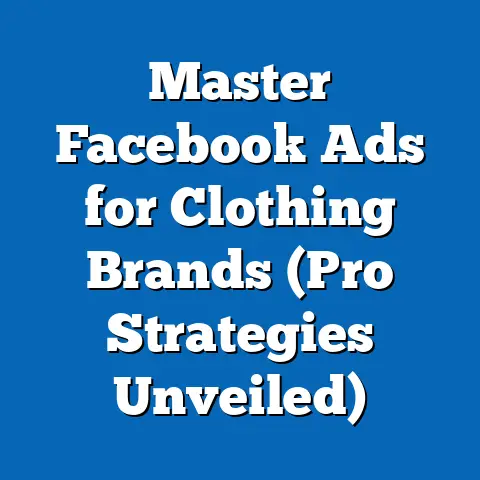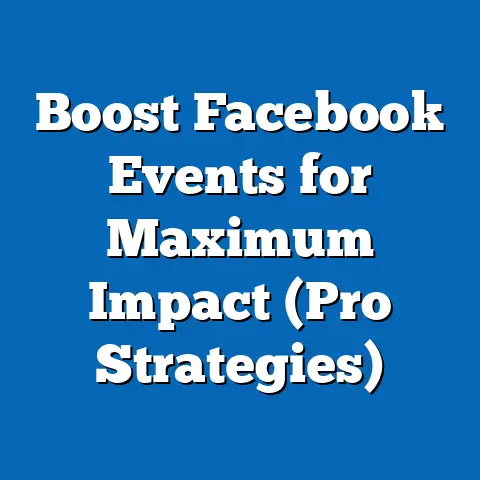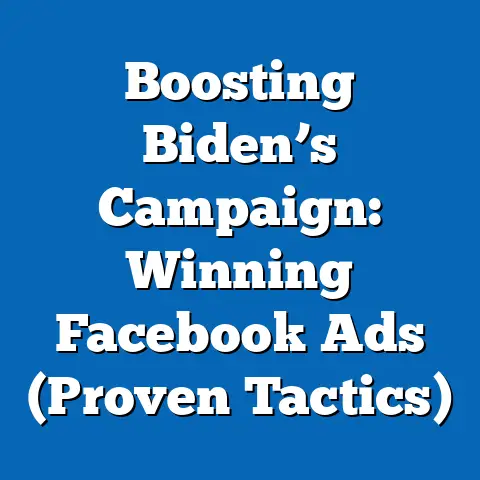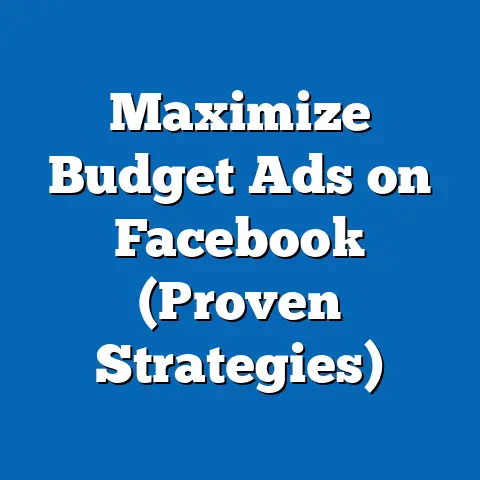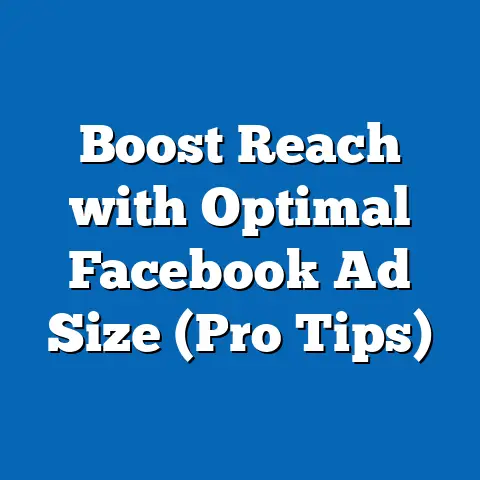Mastering Facebook Ad Rules (Expert Strategies Unveiled)
Navigating the ever-evolving landscape of Facebook advertising can feel like traversing a minefield. One wrong step, one misinterpreted rule, and your ad account could face penalties, your reach could be limited, and your hard-earned budget could go to waste. I’ve seen it happen countless times – enthusiastic marketers launching campaigns only to be blindsided by a policy violation they didn’t even know existed.
But what if I told you that mastering Facebook’s ad rules isn’t just about avoiding penalties? It’s about unlocking the true potential of the platform, enhancing your ad performance, and ultimately driving better results for your business. Think of it as learning the rules of a game – once you understand them, you can play strategically and win.
In fact, a recent study by HubSpot found that businesses that consistently adhere to Facebook’s advertising policies see a 25% higher engagement rate on their ads compared to those that don’t. That’s a significant difference!
This guide isn’t just about compliance; it’s about thriving in the Facebook advertising ecosystem. I’m going to share expert strategies that not only ensure your ads meet Facebook’s guidelines but also maximize their impact, reduce your costs, and improve your overall ROI. Get ready to transform your Facebook advertising from a source of frustration into a powerful engine for growth.
Section 1: Understanding Facebook’s Advertising Policies
Facebook’s advertising policies are the bedrock of a fair and transparent advertising ecosystem. They exist to protect users, maintain the integrity of the platform, and ensure a positive experience for everyone. Ignoring them is like driving without a license – sooner or later, you’re going to get pulled over.
Overview of Facebook’s Ad Policies
At their core, Facebook’s ad policies outline what you can and cannot promote on the platform. These policies cover a wide range of topics, including:
- Prohibited Content: This includes anything illegal, discriminatory, misleading, or deceptive. Think scams, hate speech, counterfeit goods, and exaggerated claims.
- Restricted Content: This category covers sensitive topics that require special approval or targeting limitations. Examples include alcohol, gambling, health and fitness products, political ads, and dating services.
- Prohibited Practices: This refers to tactics that manipulate the system or exploit users. Examples include clickbait, sensationalism, and circumvention of Facebook’s review process.
- Community Standards: These are the overarching guidelines that govern acceptable behavior on Facebook. Your ads should align with these standards and avoid content that is offensive, harassing, or threatening.
I remember once working with a client who ran a health supplement company. They were using before-and-after photos in their ads, promising unrealistic weight loss results. Their ads were repeatedly disapproved, and their account was eventually restricted. It took a lot of effort to educate them on Facebook’s policies and help them create compliant ads that focused on healthy lifestyle choices instead of quick fixes.
Importance of Compliance
Why is compliance so important? It’s not just about avoiding penalties; it’s about building a sustainable and successful advertising strategy. Here’s why you should prioritize adhering to Facebook’s ad policies:
- Account Standing: Repeated violations can lead to account restrictions or even permanent bans. This means you’ll lose access to Facebook’s advertising platform entirely, crippling your ability to reach your target audience.
- Ad Reach: Non-compliant ads are often disapproved or have their reach significantly limited. This means fewer people will see your ads, resulting in lower engagement and fewer conversions.
- Ad Costs: Facebook rewards advertisers who create high-quality, compliant ads. Non-compliant ads are often penalized with higher costs per click or impression, making your campaigns less efficient.
- Brand Reputation: Running ads that violate Facebook’s policies can damage your brand’s reputation and erode trust with your audience.
- Long-Term Sustainability: Building a compliant advertising strategy ensures you can continue running ads on Facebook for the long term, without fear of penalties or restrictions.
Categories of Restrictions
Let’s dive deeper into some of the key categories of restrictions you need to be aware of:
- Adult Content: Ads promoting adult products, services, or imagery are strictly prohibited. This includes anything sexually suggestive, explicit, or exploitative.
- Alcohol: Ads promoting alcohol are subject to age and location restrictions. You need to target your ads appropriately and ensure they comply with local laws and regulations.
- Gambling: Ads promoting online gambling or casinos are heavily regulated and require prior authorization from Facebook.
- Health and Fitness Products: Ads making health claims or promoting weight loss products are subject to strict scrutiny. You need to provide scientific evidence to support your claims and avoid making unrealistic promises.
- Political Ads: Ads related to political issues, candidates, or elections require special disclaimers and transparency requirements.
- Dating Services: Ads promoting dating services need to be targeted to adults and avoid sexually suggestive content.
- Financial Products and Services: Ads promoting financial products like loans, credit cards, or investment opportunities need to be clear, transparent, and avoid misleading claims.
Key Takeaway: Understanding Facebook’s advertising policies is the first step towards creating successful and sustainable campaigns. Familiarize yourself with the guidelines and ensure your ads comply with all applicable rules and regulations.
Next Step: Review Facebook’s official advertising policies (available on their website) and identify any areas where your current ads might be non-compliant.
Section 2: Common Pitfalls and How to Avoid Them
Even with a solid understanding of Facebook’s advertising policies, it’s easy to fall into common traps that can lead to ad disapprovals and account penalties. I’ve seen even experienced marketers make these mistakes, often due to oversight or a lack of attention to detail.
Case Studies of Common Violations
Let’s look at some real-world examples of brands that have faced penalties due to policy violations:
- Example 1: The “Miracle Cure” Claim: A company selling a dietary supplement claimed their product could cure a specific disease. This violated Facebook’s policy against making unsubstantiated health claims. Their ads were disapproved, and their account received a warning.
- Example 2: The “Get Rich Quick” Scheme: An ad promoting an online course promised users they could become millionaires in a matter of weeks. This violated Facebook’s policy against misleading or deceptive advertising. The ad was flagged for clickbait and removed.
- Example 3: The “Before and After” Photo Fail: A fitness company used before-and-after photos in their ads that were deemed unrealistic and misleading. This violated Facebook’s policy against promoting unhealthy body image. Their ads were disapproved, and they had to revise their creative.
- Example 4: The “Data Privacy Breach”: A company was collecting user data through a lead generation form without properly disclosing how the data would be used. This violated Facebook’s policy on data privacy. Their ad account was temporarily suspended.
These examples highlight the importance of being vigilant and proactive in ensuring your ads comply with Facebook’s policies.
Tips for Avoiding Pitfalls
Here are some actionable strategies to avoid these common mistakes:
- Thoroughly Review Your Ad Copy: Before launching any ad, carefully review your ad copy to ensure it’s clear, accurate, and doesn’t make any misleading or unsubstantiated claims. Avoid using sensational language, clickbait, or exaggerated promises.
- Choose Your Images Wisely: Select images that are relevant, high-quality, and compliant with Facebook’s guidelines. Avoid using images that are sexually suggestive, violent, or promote unhealthy body image.
- Be Transparent About Data Collection: If you’re collecting user data through lead generation forms or other means, be transparent about how you’re using the data and obtain explicit consent from users.
- Target Your Audience Appropriately: Use Facebook’s targeting tools responsibly and avoid targeting vulnerable groups or engaging in discriminatory practices.
- Stay Updated on Policy Changes: Facebook’s advertising policies are constantly evolving. Make sure to stay informed about the latest changes and update your ads accordingly. I recommend subscribing to Facebook’s official advertising blog and following industry news sources.
- Get a Second Opinion: Before launching a campaign, ask a colleague or friend to review your ads for compliance. A fresh pair of eyes can often spot potential issues you might have missed.
Use of Facebook’s Ad Review Process
Facebook’s ad review process is designed to ensure that all ads comply with their advertising policies. Here’s how it works and how you can leverage it to your advantage:
- Automated Review: When you submit an ad, it’s first reviewed by an automated system that checks for common violations. This process usually takes a few minutes to a few hours.
- Human Review: If the automated system flags your ad for potential violations, it’s then reviewed by a human reviewer. This process can take longer, sometimes up to 24 hours or more.
- Ad Disapproval: If your ad is found to violate Facebook’s policies, it will be disapproved, and you’ll receive a notification explaining the reason for the disapproval.
- Appealing a Disapproval: If you believe your ad was unfairly disapproved, you can appeal the decision. Facebook will then review your ad again and make a final determination.
To leverage the ad review process to your advantage:
- Submit Ads Early: Don’t wait until the last minute to submit your ads. Give yourself plenty of time for the review process and any necessary revisions.
- Understand the Reasons for Disapproval: If your ad is disapproved, carefully read the notification and understand the specific reason for the disapproval.
- Make Necessary Revisions: Revise your ad to address the specific violations identified by Facebook.
- Appeal If Necessary: If you believe your ad was unfairly disapproved, don’t hesitate to appeal the decision. Provide clear and concise arguments to support your case.
Key Takeaway: Avoiding common pitfalls and understanding the ad review process can save you time, money, and frustration. Be proactive in ensuring your ads comply with Facebook’s policies.
Next Step: Review your past ad campaigns and identify any instances where you may have violated Facebook’s policies. Learn from these mistakes and implement the strategies outlined above to avoid future violations.
Section 3: Best Practices for Crafting Compliant Ads
Creating compliant ads doesn’t mean sacrificing creativity or effectiveness. In fact, I believe that adhering to Facebook’s guidelines can actually force you to be more creative and strategic in your approach. It’s about finding innovative ways to engage your audience while staying within the bounds of the platform’s rules.
Creating Engaging and Compliant Ad Copy
Writing compelling ad copy that adheres to Facebook’s guidelines requires a delicate balance. You need to capture your audience’s attention, convey your message effectively, and avoid making any claims that could be considered misleading or deceptive.
Here are some tips for creating engaging and compliant ad copy:
- Focus on Benefits, Not Features: Instead of simply listing the features of your product or service, focus on the benefits it provides to your customers. How will it improve their lives? What problems will it solve?
- Use Clear and Concise Language: Avoid using jargon, technical terms, or overly complex language. Keep your message simple and easy to understand.
- Be Honest and Transparent: Don’t make exaggerated claims or promise unrealistic results. Be honest and transparent about what your product or service can and cannot do.
- Use Strong Calls to Action: Tell your audience what you want them to do. Use clear and compelling calls to action that encourage them to click, learn more, or make a purchase.
- Avoid Sensitive Topics: Steer clear of sensitive topics like race, religion, gender, or sexual orientation. These topics can be divisive and may violate Facebook’s policies against discrimination.
- Proofread Carefully: Before launching your ad, proofread your ad copy carefully to catch any typos, grammatical errors, or inconsistencies.
I once worked with a client who was selling a language learning app. Their initial ad copy focused on the app’s advanced features and technical capabilities. However, their ads weren’t performing well. After revising their ad copy to focus on the benefits of learning a new language (e.g., improved career opportunities, enhanced travel experiences, increased confidence), their engagement rates skyrocketed.
Visual Content Guidelines
Visual content plays a crucial role in capturing your audience’s attention and conveying your message effectively. However, it’s also important to ensure that your images and videos comply with Facebook’s guidelines.
Here are some tips for selecting images and videos that are not only compliant but also enhance ad performance:
- Use High-Quality Images and Videos: Choose images and videos that are clear, sharp, and well-lit. Avoid using blurry, pixelated, or low-resolution content.
- Be Relevant to Your Message: Ensure that your images and videos are relevant to your ad copy and your overall message. They should complement your message and help to reinforce your brand.
- Avoid Sexually Suggestive Content: Avoid using images or videos that are sexually suggestive, explicit, or exploitative.
- Respect Copyright Laws: Make sure you have the rights to use any images or videos you include in your ads. Avoid using copyrighted material without permission.
- Consider Mobile Optimization: Optimize your images and videos for mobile devices. Most Facebook users access the platform on their phones, so it’s important to ensure your content looks good on smaller screens.
- Test Different Visuals: A/B test different images and videos to see which ones perform best with your target audience.
Targeting and Audience Considerations
Facebook’s targeting tools are incredibly powerful, allowing you to reach specific audiences based on demographics, interests, behaviors, and more. However, it’s important to use these tools responsibly and avoid violating privacy or discrimination policies.
Here are some tips for effectively using Facebook’s targeting tools without violating policy guidelines:
- Avoid Discriminatory Targeting: Don’t target or exclude users based on sensitive characteristics like race, ethnicity, religion, gender, sexual orientation, or disability.
- Respect User Privacy: Be transparent about how you’re collecting and using user data. Obtain explicit consent from users before collecting their data.
- Use Custom Audiences Responsibly: When using custom audiences (e.g., email lists, website visitors), make sure you have obtained the necessary permissions from users.
- Target Broadly When Appropriate: In some cases, it may be more effective to target a broad audience rather than a highly specific one. This can help you reach new customers and avoid violating privacy policies.
- Monitor Your Targeting Performance: Regularly monitor your targeting performance and make adjustments as needed. If you’re not seeing the results you expect, try experimenting with different targeting options.
I’ve found that one of the most effective ways to ensure compliance with targeting policies is to focus on interest-based targeting. Instead of targeting users based on demographics, try targeting them based on their interests, hobbies, or passions. This can help you reach a highly engaged audience without violating privacy or discrimination policies.
Key Takeaway: Crafting compliant ads requires a combination of creativity, strategy, and attention to detail. By following these best practices, you can create ads that are not only compliant but also highly effective in reaching your target audience and driving results.
Next Step: Review your current ad creative and targeting strategies to ensure they comply with Facebook’s guidelines. Make any necessary revisions to address potential violations.
Section 4: Advanced Strategies for Maximizing Ad Performance
Once you’ve mastered the basics of Facebook advertising and compliance, you can start exploring advanced strategies to maximize your ad performance and drive even better results. These strategies involve leveraging data, testing different approaches, and continuously optimizing your campaigns.
A/B Testing for Compliance and Performance
A/B testing is a powerful technique for identifying the most effective ad variations while ensuring compliance with Facebook’s policies. By testing different elements of your ads, you can determine which ones resonate best with your audience and drive the most conversions.
Here are some tips for using A/B testing to find compliant and high-performing ad variations:
- Test One Element at a Time: When conducting A/B tests, focus on testing one element at a time (e.g., headline, image, call to action). This will make it easier to isolate the impact of each element on your ad performance.
- Create Clear Hypotheses: Before launching your A/B tests, create clear hypotheses about which variations you expect to perform best and why. This will help you stay focused and avoid wasting time on irrelevant tests.
- Use a Large Enough Sample Size: Make sure you have a large enough sample size to draw statistically significant conclusions from your A/B tests.
- Track Key Metrics: Track key metrics like click-through rate (CTR), conversion rate, and cost per acquisition (CPA) to measure the performance of your different ad variations.
- Iterate and Optimize: Based on the results of your A/B tests, iterate and optimize your ads to improve their performance. Continuously test new variations to stay ahead of the curve.
I’ve found that one of the most effective A/B testing strategies is to test different ad copy variations that focus on different benefits of your product or service. This can help you identify which benefits resonate most strongly with your target audience and tailor your messaging accordingly.
Leveraging Facebook Insights
Facebook Insights provides a wealth of data about your audience, your ads, and your overall performance. By leveraging this data, you can gain valuable insights into what’s working and what’s not, and refine your ad strategies accordingly.
Here’s how to use Facebook Insights and Analytics to refine your ad strategies:
- Understand Your Audience: Use Facebook Insights to learn more about your audience’s demographics, interests, behaviors, and more. This information can help you refine your targeting strategies and create more relevant ads.
- Track Key Metrics: Track key metrics like reach, engagement, and conversions to measure the performance of your ads.
- Identify Top-Performing Ads: Use Facebook Insights to identify your top-performing ads and understand what makes them so successful.
- Analyze Ad Performance by Demographic: Analyze your ad performance by demographic to identify which segments of your audience are most responsive to your ads.
- Monitor Ad Fatigue: Monitor ad fatigue to identify when your audience is starting to tune out your ads. When this happens, it’s time to refresh your creative or adjust your targeting.
I always tell my clients to treat Facebook Insights as their personal advertising detective. It’s there to uncover the hidden clues that will lead them to advertising success.
Retargeting Strategies within Policy Guidelines
Retargeting is a powerful technique for reaching users who have previously interacted with your website or your ads. However, it’s important to implement retargeting campaigns that comply with Facebook’s rules and respect user privacy.
Here’s how to effectively implement retargeting campaigns that comply with Facebook’s rules:
- Use Website Custom Audiences: Create website custom audiences to retarget users who have visited your website.
- Use Engagement Custom Audiences: Create engagement custom audiences to retarget users who have interacted with your Facebook page or your ads.
- Exclude Users Who Have Already Converted: Exclude users who have already converted from your retargeting campaigns. This will prevent you from wasting money on users who are already customers.
- Be Transparent About Retargeting: Be transparent about your retargeting practices and let users know that they are being retargeted.
- Provide Opt-Out Options: Give users the option to opt out of your retargeting campaigns.
One of my favorite retargeting strategies is to create a custom audience of users who have abandoned their shopping carts on your website. You can then retarget these users with ads that offer a discount or free shipping to encourage them to complete their purchase.
Key Takeaway: Mastering advanced strategies like A/B testing, Facebook Insights, and retargeting can help you maximize your ad performance and drive even better results. However, it’s important to implement these strategies responsibly and ensure they comply with Facebook’s policies.
Next Step: Start experimenting with A/B testing, Facebook Insights, and retargeting to identify opportunities for improvement in your ad campaigns.
Section 5: Future Trends in Facebook Advertising and Policy Changes
The world of Facebook advertising is constantly evolving, with new trends and policy changes emerging all the time. To stay ahead of the curve, it’s important to anticipate these changes and adapt your strategies accordingly. I’ve learned that the only constant in digital marketing is change, so embracing it is essential for long-term success.
Emerging Trends in Advertising
Here are some of the key emerging trends in Facebook advertising:
- The Rise of Video Content: Video content is becoming increasingly popular on Facebook, and advertisers are finding that video ads tend to perform better than static image ads.
- The Importance of Transparency: Consumers are demanding more transparency from advertisers, and Facebook is responding by implementing new policies that require advertisers to be more upfront about their data collection and targeting practices.
- The Growing Focus on Privacy: Data privacy is a major concern for consumers, and Facebook is taking steps to protect user privacy by limiting the amount of data that advertisers can collect and use.
- The Increasing Use of Automation: Automation is becoming increasingly important in Facebook advertising, with tools like automated bidding and dynamic creative optimization helping advertisers to streamline their campaigns and improve their results.
- The Continued Dominance of Mobile: Mobile devices continue to dominate Facebook usage, so it’s essential to optimize your ads for mobile screens.
Anticipating Policy Changes
Facebook’s advertising policies are constantly evolving to reflect changes in technology, consumer behavior, and regulatory requirements. To stay informed about potential changes, I recommend:
- Subscribing to Facebook’s Official Advertising Blog: This blog provides updates on new policies, features, and best practices.
- Following Industry News Sources: Stay informed about industry news and trends by following reputable marketing blogs, websites, and social media accounts.
- Participating in Online Communities: Join online communities of Facebook advertisers to share insights and learn from others.
- Attending Industry Events: Attend industry conferences and webinars to stay up-to-date on the latest trends and best practices.
Adapting to Algorithm Changes
Facebook’s algorithm is constantly changing, and these changes can have a significant impact on your ad performance. To adapt to algorithm changes, I recommend:
Key Takeaway: The future of Facebook advertising is uncertain, but by staying informed about emerging trends, anticipating policy changes, and adapting to algorithm updates, you can position yourself for long-term success.
Next Step: Start monitoring industry news sources and participating in online communities to stay up-to-date on the latest trends and best practices in Facebook advertising.
Conclusion: The Path to Advertising Success on Facebook
Mastering Facebook’s ad rules is not just about avoiding penalties; it’s about unlocking the true potential of the platform and achieving advertising success. By understanding the policies, avoiding common pitfalls, crafting compliant ads, leveraging advanced strategies, and staying informed about future trends, you can create campaigns that are not only compliant but also highly effective in reaching your target audience and driving results.
I’ve seen firsthand the transformational potential of well-crafted, compliant Facebook ads. They can drive business growth, maximize ROI, and help you build a strong and sustainable brand. But it all starts with understanding and adhering to the rules.
The strategies outlined in this guide are not just theoretical concepts; they are practical, actionable steps that you can implement in your own campaigns. By taking the time to learn and apply these strategies, you can transform your Facebook advertising from a source of frustration into a powerful engine for growth.
Remember, the journey to advertising success on Facebook is a marathon, not a sprint. It requires patience, persistence, and a willingness to learn and adapt. But with the right knowledge and the right strategies, you can achieve your advertising goals and build a thriving business.
Call to Action
Now that you’ve learned the expert strategies for mastering Facebook ad rules, it’s time to put them into practice. Revisit your current ad campaigns and apply the strategies discussed in this guide. Identify any areas where you may be violating Facebook’s policies and make the necessary revisions.
Don’t be afraid to experiment, test different approaches, and learn from your mistakes. The key is to stay persistent, stay informed, and stay compliant.
I’d love to hear about your experiences with Facebook advertising and compliance. Share your questions, comments, or success stories in the comments below. Let’s learn from each other and build a community of successful Facebook advertisers.
And if you’re ready to take your Facebook advertising to the next level, consider investing in professional training or consulting. A qualified expert can provide personalized guidance and help you develop a winning strategy that is tailored to your specific business needs.
The world of Facebook advertising is constantly changing, but by mastering the rules and staying ahead of the curve, you can achieve lasting success and unlock the full potential of this powerful platform. So go out there, create amazing ads, and drive results!

